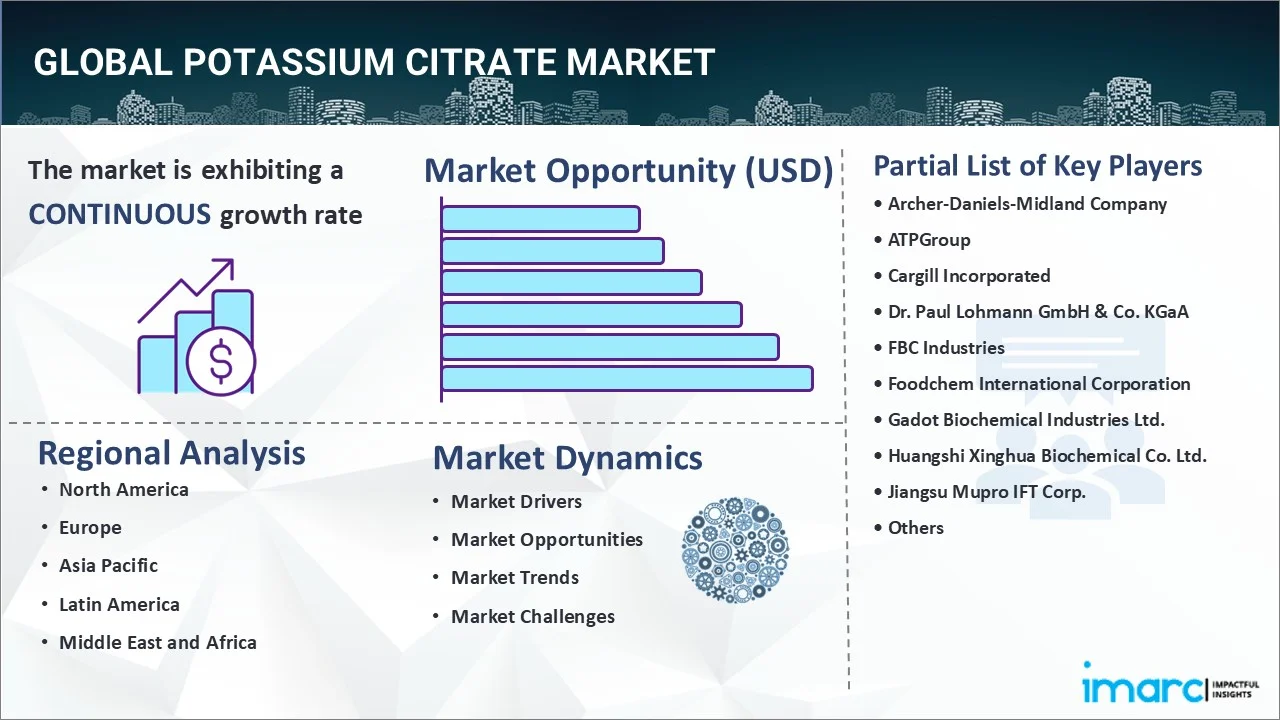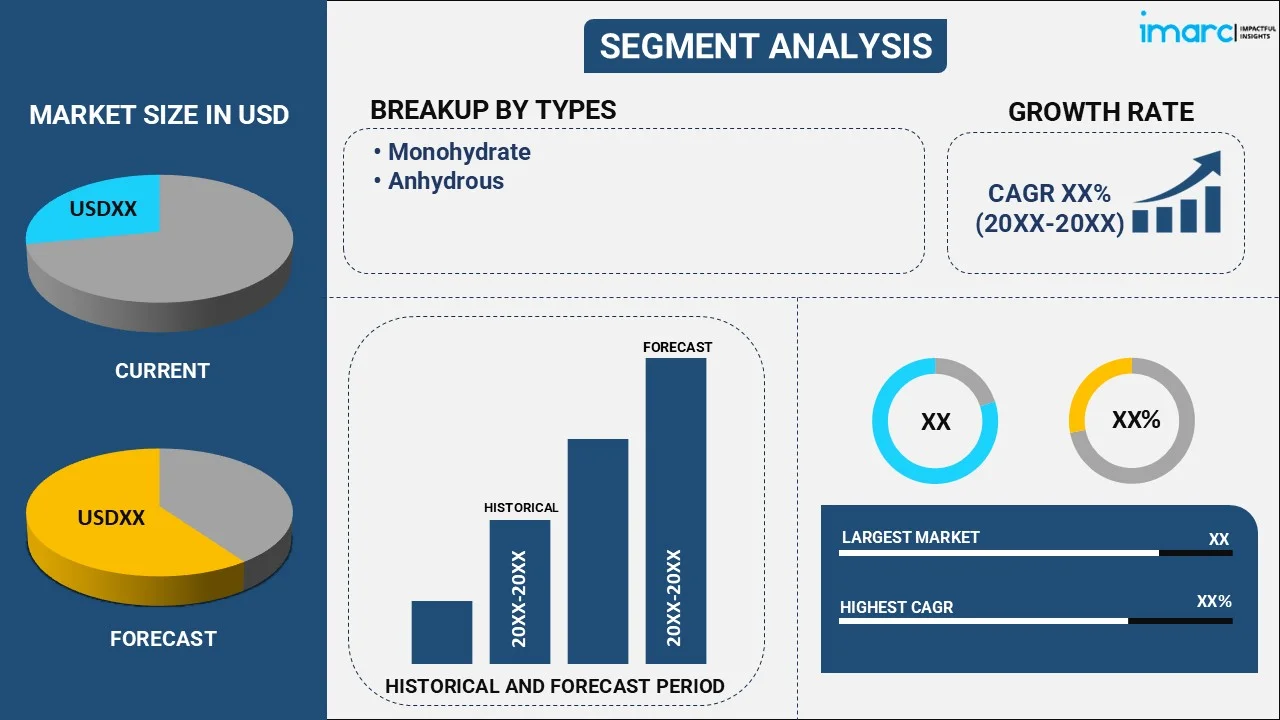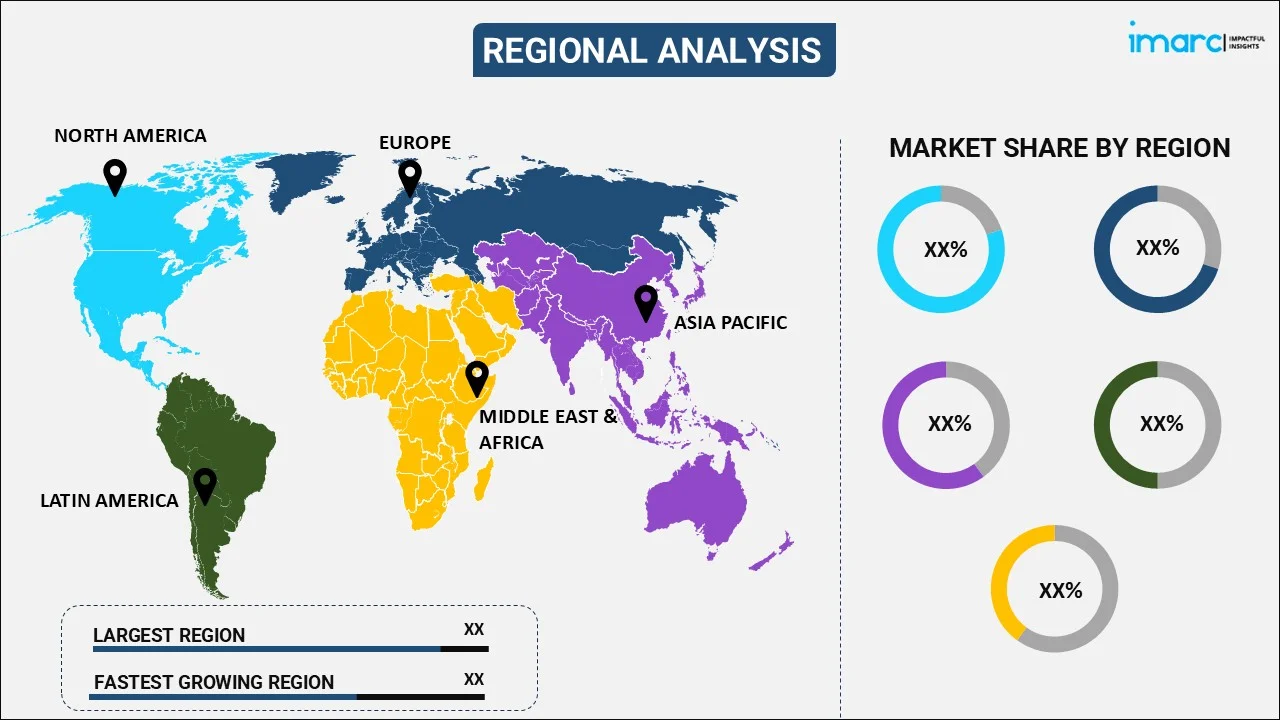
Potassium Citrate Market Report by Type (Monohydrate, Anhydrous), Function (Acidulant, Emulsifier, Stabilizer, Antioxidants, and Others), End User (Food and Beverages, Pharmaceuticals, Personal Care, and Others), and Region 2025-2033
Potassium Citrate Market Overview:
The global potassium citrate market size reached USD 777.9 Million in 2024. Looking forward, IMARC Group expects the market to reach USD 1,047.4 Million by 2033, exhibiting a growth rate (CAGR) of 3.36% during 2025-2033. The growing use in the food and beverages (F&B) sector for improving flavor, stability, and shelf life, rising demand in the pharmaceutical industry for treating kidney stones and urinary tract infections, and increasing popularity of processed and convenience food among busy individuals are some of the factors impelling the market growth.
|
Report Attribute
|
Key Statistics
|
|---|---|
|
Base Year
|
2024
|
|
Forecast Years
|
2025-2033
|
|
Historical Years
|
2019-2024
|
| Market Size in 2024 | USD 777.9 Million |
| Market Forecast in 2033 | USD 1,047.4 Million |
| Market Growth Rate (2025-2033) | 3.36% |
Potassium Citrate Market Analysis:
- Major Market Drivers: The market is experiencing a steady growth because of the rising use of potassium citrate in the pharmaceutical industry, particularly in treatments for kidney stones and urinary tract infections (UTI).
- Key Market Trends: There is a shift towards the use of potassium citrate in the production of low-sodium food products, catering to the health-conscious population. Moreover, innovations in the production of functional foods and dietary supplements that include potassium citrate are also becoming prevalent.
- Geographical Trends: Asia Pacific dominates the market because of the growing demand for potassium citrate in the food and pharmaceutical sectors.
- Competitive Landscape: Some of the major market players in the potassium citrate industry include Archer-Daniels-Midland Company, ATPGroup, Cargill Incorporated, Dr. Paul Lohmann GmbH & Co. KGaA, FBC Industries, Foodchem International Corporation, Gadot Biochemical Industries Ltd., Huangshi Xinghua Biochemical Co. Ltd., Jiangsu Mupro IFT Corp., Jungbunzlauer Suisse AG, Niran BioChemical Limited, RZBC Group Co. Ltd. and Tate & Lyle PLC., among many others.
- Challenges and Opportunities: The fluctuating raw material prices, which can impact production costs and pricing strategies, are influencing the potassium citrate market revenue. Nonetheless, the industry offers potential for growth, especially in emerging nations where processed foods and health supplements are becoming more popular.

Potassium Citrate Market Trends:
Rising Demand for Processed Foods
Potassium citrate is commonly utilized in the processed food sector for improving taste, enhancing consistency, and prolonging the shelf life. The increasing urbanization and people leading busier lives are driving the need for convenient, ready-to-eat (RTE) foods. The size of the worldwide market for ready-to-eat (RTE) food hit US$ 181.5 Billion in 2023. In the future, IMARC Group predicts that the market will achieve a value of US$ 262.4 Billion by 2032, showing a 4.18% growth rate (CAGR) between 2024 and 2032. This increase is resulting in higher utilization of food additives like potassium citrate to uphold the standard and steadiness of processed foods. Moreover, people are becoming aware about their health and are looking for products that have reduced sodium levels. Potassium citrate is a perfect alternative to sodium additives, assisting manufacturers in satisfying the need for healthier food choices. The rising demand for processed food, influenced by evolving consumer tastes and advancements in food processing technologies, is supporting the potassium citrate market growth.
Demand in the Pharmaceutical Sector
The growing use of potassium citrate in the pharmaceutical industry, because of its widespread usage in different medical products, is offering a favorable market outlook. Potassium citrate is greatly appreciated for its role as a potent alkalizing agent in the treatment of kidney stones and urinary tract infections (UTIs). Its ability to balance out extra acids in the urine makes it a favored option for treating conditions such as metabolic acidosis. The rising occurrence of chronic kidney diseases and urinary disorders among the masses is driving the need for medications containing potassium citrate. Moreover, the compound is also used in effervescent tablets and powders to improve their effectiveness and stability. The increasing emphasis on enhancing patient health results and the growing funding in healthcare facilities play a vital role in the demand for potassium citrate in the pharmaceutical field. In 2023, the pharmaceutical market in India was valued at US$ 54.6 billion. The IMARC Group projects that the market will expand at a compound annual growth rate (CAGR) of 12.3% from 2024 to 2032, reaching US$ 163.1 billion in 2032. Potassium citrate market recent developments include breakthroughs in drug formulations and innovative delivery methods that improve the efficacy and stability of potassium citrate-based treatments, further driving the demand in this sector.
Growing Health Awareness and Dietary Supplements Demand
The increasing understanding about the advantages of maintaining a healthy mineral balance and avoiding kidney stones is leading to a rise in the popularity of dietary supplements with potassium citrate. This substance is well known for its capacity to promote kidney well-being by averting the creation of kidney stones and helping in the control of urinary infections. The increasing occurrence of lifestyle-related diseases like high blood pressure and weight gain is catalyzing the demand for supplements that can assist in controlling these conditions. In 2023, the World Health Organization (WHO) published its first report on the global effects of elevated blood pressure. Approximately 80% of individuals with hypertension do not receive sufficient treatment, according to the report. However, if countries can expand coverage, roughly 76 million deaths could be prevented from 2023 to 2050.
Potassium Citrate Market Segmentation:
IMARC Group provides an analysis of the key trends in each segment of the global potassium citrate market report, along with forecasts at the global, regional and country levels from 2025-2033. Our report has categorized the market based on type, function and end user.
Breakup by Type:

- Monohydrate
- Anhydrous
The report has provided a detailed breakup and analysis of the market based on the type. This includes monohydrate and anhydrous.
Monohydrate is characterized by its widespread use in the pharmaceutical and food and beverage (F&B) industries. Monohydrate potassium citrate is greatly appreciated in the pharmaceutical industry for its efficacy as an alkalizing agent, especially in the management of kidney stones and UTI among the elderly. According to the October 2023 report presented by the UK Health Security Agency (UKHSA) and National Health Service (NHS) of England, 56% (82,392) of the 147,285 admissions for UTI in the 2022/23 period were individuals aged 65 and older. The 80-84 age group had the most admissions at 17,280. The F&B industry gains advantages from it as a buffering and sequestrant agent, maintaining product stability and quality. The increasing recognition of health and wellness by consumers is leading to a strong demand for dietary supplements with monohydrate potassium citrate.
Anhydrous, valued for its exceptional purity and reliability, is widely used in industries that demand strict quality requirements. The pharmaceutical sector uses anhydrous potassium citrate in formulations for products that are sensitive to moisture, guaranteeing extended shelf life and effectiveness. Its function as a buffering agent in the food industry is crucial for ensuring the pH balance of beverages and other products. The dehydrated version is especially preferred for making effervescent tablets and powders because the absence of water is critical to the efficacy of the product.
Breakup by Function:
- Acidulant
- Emulsifier
- Stabilizer
- Antioxidants
- Others
Emulsifier exhibits a clear dominance in the market
A detailed breakup and analysis of the market based on the function have also been provided in the report. This includes acidulant, emulsifier, stabilizer, antioxidants, and others. According to the report, emulsifier accounted for the largest market share.
Emulsifier holds the largest portion of market, as it plays a vital role in preserving the texture and stability of different food and beverage items. Potassium citrate is commonly utilized as an emulsifier in dairy products and processed foods to maintain a consistent blend and avoid ingredient separation. In 2023, the worldwide dairy market was valued at US$ 944.7 Billion, with forecasts from the IMARC Group suggesting it will grow to US$ 1,459.3 Billion by 2032. The increasing desire for convenient food products and ready to eat meals is catalyzing the demand for efficient emulsifiers, leading to higher potassium citrate demand in this role. Furthermore, the growing desire for clean-label and natural food additives is driving the need for potassium citrate as a favored emulsifier because of its safe and versatile properties. It is anticipated that the segment will maintain its leadership position due to continuous innovations and the increasing use of potassium citrate in both new and existing food items.
Breakup by End User:
- Food and Beverages
- Pharmaceuticals
- Personal Care
- Others
Food and beverages are the predominant market segment
A detailed breakup and analysis of the market based on the end user have also been provided in the report. This includes food and beverages, pharmaceuticals, personal care, and others. According to the report, food and beverages accounted for the largest market share.
Food and beverages are the largest segment according to the potassium citrate market outlook due to its increasing use as an additive to improve flavor, stability, and shelf life. Potassium citrate is frequently utilized as a buffering agent, acidulant, and emulsifier in various products, such as dairy items, beverages, processed foods, and bakery goods. Its role in controlling level of acidity and enhancing texture is essential in upholding the quality and uniformity of the product. The growing number of consumers favoring low-sodium and healthier food choices is catalyzing the demand for potassium citrate, as it aids in achieving desired flavors without sacrificing health advantages. The increasing popularity of convenient foods and continuous advancements in food processing technologies are also contributing to the growth of the sector, guaranteeing that potassium citrate continues to be a crucial component in the F&B industry.
Breakup by Region:

- North America
- United States
- Canada
- Asia-Pacific
- China
- Japan
- India
- South Korea
- Australia
- Indonesia
- Others
- Europe
- Germany
- France
- United Kingdom
- Italy
- Spain
- Russia
- Others
- Latin America
- Brazil
- Mexico
- Others
- Middle East and Africa
Asia Pacific leads the market, accounting for the largest potassium citrate market share
The report has also provided a comprehensive analysis of all the major regional markets, which include North America (the United States and Canada); Asia Pacific (China, Japan, India, South Korea, Australia, Indonesia, and others); Europe (Germany, France, the United Kingdom, Italy, Spain, Russia, and others); Latin America (Brazil, Mexico, and others); and the Middle East and Africa. According to the report, Asia Pacific represents the largest regional market for potassium citrate.
The Asia Pacific region is the largest segment in the market, driven by rapid industrialization, urbanization, and growing consumer awareness regarding health and wellness. According to the China in Numbers (2023) report by the United Nations Development Programme (UNDP), the percentage of individuals permanently residing in urban areas has more than tripled since 1982, reaching 66.2% in 2023. The increasing need for potassium citrate in this region is because of the expanding F&B industry and the growing pharmaceutical sector. The rising health-consciousness among consumers in Asia Pacific is resulting in a greater intake of dietary supplements and functional foods which frequently include potassium citrate. Furthermore, the robust agricultural foundation aids in providing a constant source of raw materials for the production of potassium citrate.
Competitive Landscape:
- The market research report has also provided a comprehensive analysis of the competitive landscape in the market. Detailed profiles of all major companies have also been provided. Some of the major market players in the market include Archer-Daniels-Midland Company, ATPGroup, Cargill Incorporated, Dr. Paul Lohmann GmbH & Co. KGaA, FBC Industries, Foodchem International Corporation, Gadot Biochemical Industries Ltd., Huangshi Xinghua Biochemical Co. Ltd., Jiangsu Mupro IFT Corp., Jungbunzlauer Suisse AG, Niran BioChemical Limited, RZBC Group Co. Ltd. and Tate & Lyle PLC.
(Please note that this is only a partial list of the key players, and the complete list is provided in the report.)
- Major potassium citrate companies are focusing on strategic efforts to enhance their market standing. They are actively engaging in product launches, strategic expansions, and regulatory approvals to strengthen their positions. For instance, Advicenne launched Sibnayal® (potassium citrate/potassium bicarbonate) in Denmark in March 2023. The Danish authorities approved its reimbursement, recognizing its therapeutic value for rare renal diseases. These companies are also increasing their manufacturing capabilities and improving their supply chain systems in order to satisfy the increasing need worldwide. Furthermore, key players are forming strategic alliances and making acquisitions in order to expand their range of products and reach in the market. They are implementing environment-friendly manufacturing processes and sourcing methods in line with the growing user demand for natural and sustainable ingredients.
Potassium Citrate Market News:
- January 2023: Gadot Biochemical Industries Ltd. expanded its value proposition for 2023, investing heavily in R&D to meet the rising demand for targeted nutraceuticals, food, beverages, and sports nutrition products. The company focused on producing and exporting organic salts, including potassium citrate, and developed new mineral solutions, such as magnesium for gummy applications.
Potassium Citrate Market Report Scope:
| Report Features | Details |
|---|---|
| Base Year of the Analysis | 2024 |
| Historical Period | 2019-2024 |
| Forecast Period | 2025-2033 |
| Units | Million USD |
| Scope of the Report | Exploration of Historical Trends and Market Outlook, Industry Catalysts and Challenges, Segment-Wise Historical and Future Market Assessment:
|
| Types Covered | Monohydrate, Anhydrous |
| Functions Covered | Acidulant, Emulsifier, Stabilizer, Antioxidants, Others |
| End Users Covered | Food and Beverages, Pharmaceuticals, Personal Care, Others |
| Regions Covered | Asia Pacific, Europe, North America, Latin America, Middle East and Africa |
| Countries Covered | United States, Canada, Germany, France, United Kingdom, Italy, Spain, Russia, China, Japan, India, South Korea, Australia, Indonesia, Brazil, Mexico |
| Companies Covered | Archer-Daniels-Midland Company, ATPGroup, Cargill Incorporated, Dr. Paul Lohmann GmbH & Co. KGaA, FBC Industries, Foodchem International Corporation, Gadot Biochemical Industries Ltd., Huangshi Xinghua Biochemical Co. Ltd., Jiangsu Mupro IFT Corp., Jungbunzlauer Suisse AG, Niran BioChemical Limited, RZBC Group Co. Ltd., Tate & Lyle PLC, etc. |
| Customization Scope | 10% Free Customization |
| Post-Sale Analyst Support | 10-12 Weeks |
| Delivery Format | PDF and Excel through Email (We can also provide the editable version of the report in PPT/Word format on special request) |
Key Benefits for Stakeholders:
- IMARC’s industry report offers a comprehensive quantitative analysis of various market segments, historical and current market trends, potassium citrate market forecasts, and dynamics of the market from 2019-2033.
- The research report provides the latest information on the market drivers, challenges, and opportunities in the market.
- The study maps the leading, as well as the fastest-growing, regional markets. It further enables stakeholders to identify the key country-level markets within each region.
- Porter's five forces analysis assists stakeholders in assessing the impact of new entrants, competitive rivalry, supplier power, buyer power, and the threat of substitution. It helps stakeholders to analyze the level of competition within the market and its attractiveness.
- The competitive landscape allows stakeholders to understand their competitive environment and provides insight into the current positions of key players in the potassium citrate industry.
Key Questions Answered in This Report
The global potassium citrate market was valued at USD 777.9 Million in 2024.
We expect the global potassium citrate market to exhibit a CAGR of 3.36% during 2025-2033.
The widespread utilization of potassium citrate in the healthcare sector, as it aids in providing body fluid volume, treating kidney stone conditions, reducing the risk of metabolic ailments, maintaining a healthy heart, etc., is primarily driving the global potassium citrate market.
The sudden outbreak of the COVID-19 pandemic had led to the implementation of stringent lockdown regulations across several nations, resulting in the temporary closure of numerous manufacturing units for potassium citrate.
Based on the function, the global potassium citrate market has been segmented into acidulant, emulsifier, stabilizer, antioxidants, and others. Among these, emulsifier represents the largest market share.
Based on the end user, the global potassium citrate market can be bifurcated into food and beverages, pharmaceuticals, personal care, and others. Currently, the food and beverage sector accounts for the majority of the total market share.
On a regional level, the market has been classified into North America, Europe, Asia-Pacific, Middle East and Africa, and Latin America, where Asia-Pacific currently dominates the global market.
Some of the major players in the global potassium citrate market include Archer-Daniels-Midland Company, ATPGroup, Cargill Incorporated, Dr. Paul Lohmann GmbH & Co. KGaA, FBC Industries, Foodchem International Corporation, Gadot Biochemical Industries Ltd., Huangshi Xinghua Biochemical Co. Ltd., Jiangsu Mupro IFT Corp., Jungbunzlauer Suisse AG, Niran BioChemical Limited, RZBC Group Co. Ltd., and Tate & Lyle PLC.
Need more help?
- Speak to our experienced analysts for insights on the current market scenarios.
- Include additional segments and countries to customize the report as per your requirement.
- Gain an unparalleled competitive advantage in your domain by understanding how to utilize the report and positively impacting your operations and revenue.
- For further assistance, please connect with our analysts.
 Inquire Before Buying
Inquire Before Buying
 Speak to an Analyst
Speak to an Analyst
 Request Brochure
Request Brochure
 Request Customization
Request Customization




.webp)




.webp)












